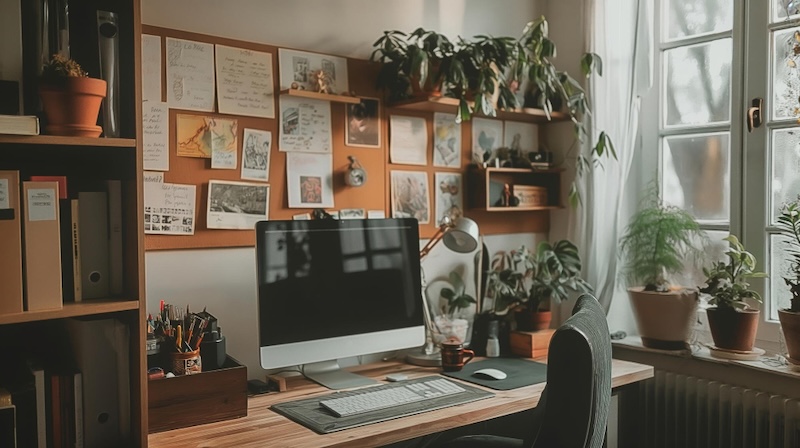The rise of online education, especially through platforms like online community college, has transformed the way we learn.
The flexibility to study anywhere, anytime, is one of the biggest perks. However, that freedom comes with its own set of challenges, especially if you’re also managing responsibilities like being a spouse, parent, or caretaker. While it’s fantastic to have the option to work from home, distractions can quickly pile up, making it tough to focus. The key to successful online learning is creating a productive virtual study space that minimizes these distractions and fosters concentration. Let’s explore how to set up your study area for maximum effectiveness.
Understanding Your Study Needs
Before you jump into decorating or arranging your study space, take a moment to think about what you need. Different tasks require different environments. Are you writing essays, doing research, or engaging in group discussions? Each of these activities might benefit from a different setup.
If you have a quiet room available, that’s fantastic! But if your home is a busy hub of activity, you’ll want to think about how to carve out a space that allows you to focus. Consider your schedule, too. Do you study better in the morning, afternoon, or late at night? Knowing when you’re most productive can help shape your space.
Choosing the Right Location
The location of your study area is crucial. Ideally, you want a place that’s away from the main hustle and bustle of your home. If you can, set up in a separate room. If that’s not possible, carve out a corner in your bedroom, living room, or even a home office.
The goal is to create a space that feels distinct from your daily activities. If you study in a place where you also relax or watch TV, it can be tough to switch your mind into “study mode.” Try to find a location that you can associate strictly with schoolwork.
Decluttering for Focus
A messy space can lead to a cluttered mind, making it hard to concentrate. Take some time to declutter your study area. Remove any unnecessary items that might distract you, like old bills, personal items, or anything unrelated to your studies.
Think about what you need on your desk. A clean, organized surface can help you feel more in control and ready to tackle your work. Use storage solutions like bins, shelves, or even a filing cabinet to keep things neat and tidy. Remember, a little organization can go a long way!
Investing in Comfort
Comfort is key when setting up your study space. If you’re going to spend hours at your desk, make sure you have a comfortable chair that supports your back. Sitting for long periods in an uncomfortable position can lead to fatigue and distract you from your studies.
Consider your desk height, too. If it’s too low or too high, it could cause strain on your neck and wrists. Your arms should be at a 90-degree angle when typing. Investing in a good chair and desk setup will help you maintain focus and energy while you work.
Lighting Matters
Good lighting can make a significant difference in how you feel while studying. Natural light is ideal, so if you can set up near a window, that’s great! But if your study area doesn’t get much natural light, make sure you have adequate artificial lighting.
A desk lamp with adjustable brightness can help reduce eye strain and keep you alert. Avoid harsh fluorescent lights that can make you feel tired and unproductive. Instead, opt for warm, soft lighting that creates a cozy atmosphere while still allowing you to see your work clearly.
Eliminating Distractions
Once you’ve got your physical space set up, it’s time to tackle distractions. In our digital age, notifications from phones, tablets, and laptops can pull you away from your studies faster than you can say “distraction.”
Try setting your phone to “Do Not Disturb” mode while you work, or even leave it in another room if you can. If you’re studying on your laptop, consider using website blockers to keep you off social media or other distracting sites. There are many apps available that can help you focus by blocking distracting content for a set period.
Incorporating Personal Touches
While minimizing distractions is important, it’s also vital to make your study space feel inviting and motivating. Personal touches can make your area more enjoyable and inspire you to work. Consider adding some of the following:
- Motivational Quotes: Write down some inspiring quotes and hang them near your desk.
- Plants: A small plant can liven up your space and improve air quality.
- Artwork or Photos: Surrounding yourself with things you love can keep you feeling positive.
Creating a space that reflects your personality can help you feel more comfortable and focused during your study sessions.
Establishing a Routine
Once your study space is ready, it’s time to develop a routine. Consistency is key when it comes to effective studying. Set specific times during the day when you’ll dedicate yourself to studying. Having a set schedule helps signal to your brain that it’s time to focus.
You might start by blocking out a couple of hours each day to hit the books. Over time, this routine will become a habit, making it easier for you to settle into your study space and get to work.
Taking Breaks and Refreshing
Even in a well-designed study space, it’s essential to take breaks. Long periods of concentration can lead to burnout and reduce your productivity. Use techniques like the Pomodoro Technique, where you study for 25 minutes and then take a 5-minute break. This approach keeps your mind fresh and engaged.
During your breaks, step away from your study area. Stretch, grab a snack, or take a short walk. This time away can help clear your mind and get you back on track when you return to your studies.
Conclusion: Your Unique Study Space Awaits
Creating a productive virtual study space is an essential step toward successful online learning. With the right location, comfort, and personal touches, you can design an environment that minimizes distractions and enhances focus. As you embark on this educational journey, remember that everyone’s ideal study space looks different. Experiment with what works for you and don’t be afraid to make adjustments along the way.
By investing time and effort into creating a space that fosters concentration, you’ll find yourself better equipped to handle the demands of your online classes. So, roll up your sleeves, get organized, and prepare to dive into a productive study experience! Happy studying!











